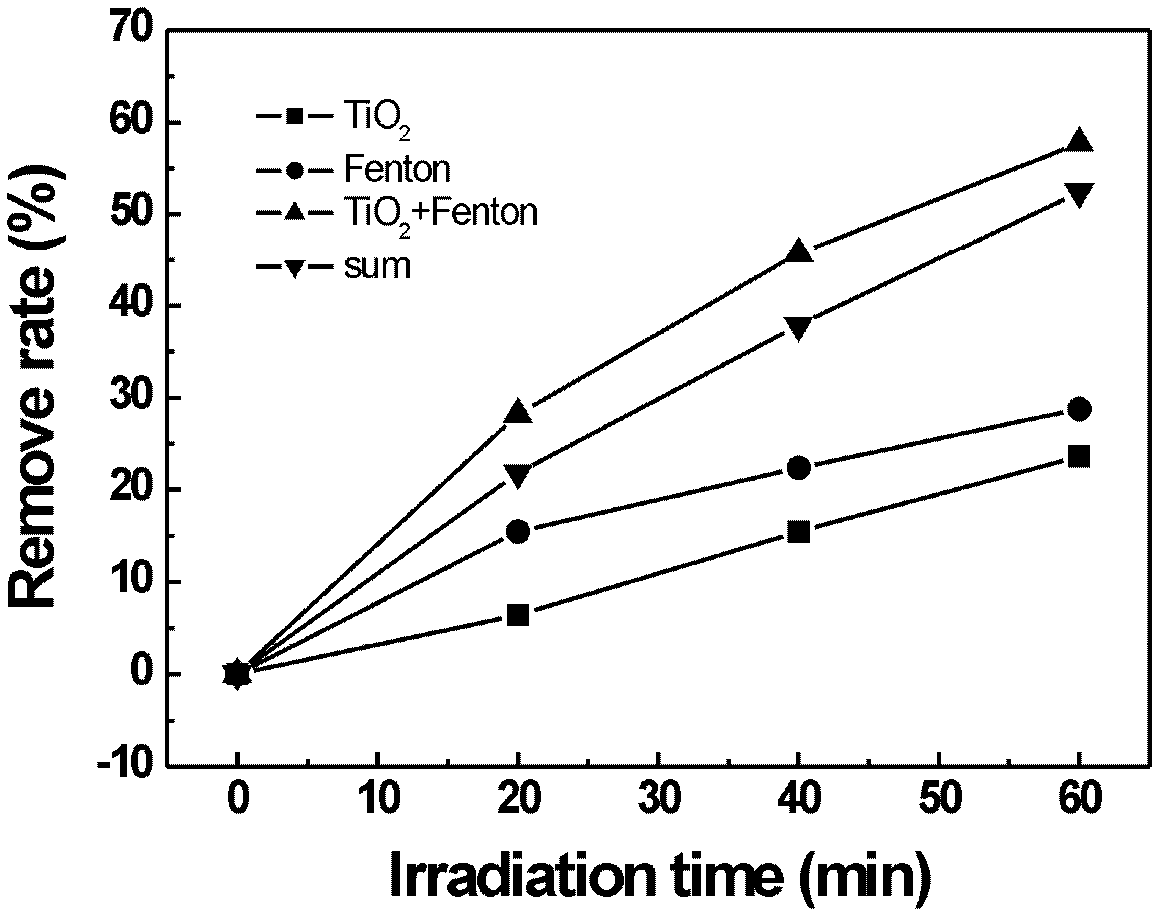Dye wastewater treatment method
A treatment method and technology for dye wastewater, applied in energy wastewater treatment, light water/sewage treatment, oxidized water/sewage treatment, etc., can solve the problems of easy dispersion and recovery, secondary pollution, difficulty, etc. The effect of dosage and cost reduction
- Summary
- Abstract
- Description
- Claims
- Application Information
AI Technical Summary
Problems solved by technology
Method used
Image
Examples
Embodiment 1
[0018] (1) The base material is an industrial titanium plate with a thickness of 2mm and a size of 5cm×8cm. The surface is polished with metallographic sandpaper until there are no scratches, cleaned ultrasonically with acetone, ethanol and three times of water, and dried for later use. Prepare an electrolyte solution of 0.5wt% HF, use an industrial titanium plate as the anode and platinum as the counter electrode at room temperature, electrochemically anodize at 30V for 1h, and then heat treat at 450°C for 2h, that is, the surface of the titanium plate is obtained. ordered TiO 2 The nanotube array film layer has an inner diameter of 80-90nm and a tube length of about 600nm.
[0019] (2)TiO 2 Nanotube arrays degrade organic wastewater. Put 500mL waste water in the reactor, adjust the pH value of the system to 3.0, and then put TiO 2 Nanotube array film layer. At the beginning of the reaction, the reaction was stirred for 30 minutes in a dark state to reach adsorption equil...
Embodiment 2
[0021] Fenton degrades organic wastewater. Put 500mL wastewater into the reactor, adjust the pH value to 3.0, add 1.5×10 -3 Fe of M 2+ Solution 2mL, 3.75×10 -3 M of H 2 o 2 Solution 3mL, and then degrade the wastewater under the irradiation of a 200W high-pressure mercury lamp, take samples every 20 minutes, measure the change of the absorbance of the wastewater, and obtain the degradation rate of the wastewater. Its photocatalytic degradation effect on wastewater is as follows: figure 1 shown. It can be seen that the degradation rate of wastewater increases with the increase of light time.
Embodiment 3
[0023] (1) TiO 2 The preparation of the nanotube array film layer is the same as in Example 1.
[0024] (2)TiO 2Nanotube arrays cooperate with Fenton's reagent to degrade organic wastewater. 500mL waste water was placed in the reactor, the pH value was adjusted to 3.0, and the TiO 2 The nanotube array film layer was put into the wastewater, and then 1.5×10 -3 Fe of M 2+ Solution 2mL, 3.75×10 -3 M of H 2 o 2 Solution 3mL. At the beginning of the reaction, the reaction was stirred for 30 minutes in a dark state to reach adsorption equilibrium, and then the wastewater was degraded under the irradiation of a 200W high-pressure mercury lamp. Samples were taken every 20 minutes to measure the change in the absorbance of the wastewater to obtain the degradation rate of the wastewater. Its photocatalytic degradation effect on wastewater is as follows: figure 1 shown. It can be seen that TiO 2 The degradation rate of wastewater by the nanotube array and Fenton synergistic ...
PUM
 Login to View More
Login to View More Abstract
Description
Claims
Application Information
 Login to View More
Login to View More - R&D
- Intellectual Property
- Life Sciences
- Materials
- Tech Scout
- Unparalleled Data Quality
- Higher Quality Content
- 60% Fewer Hallucinations
Browse by: Latest US Patents, China's latest patents, Technical Efficacy Thesaurus, Application Domain, Technology Topic, Popular Technical Reports.
© 2025 PatSnap. All rights reserved.Legal|Privacy policy|Modern Slavery Act Transparency Statement|Sitemap|About US| Contact US: help@patsnap.com

